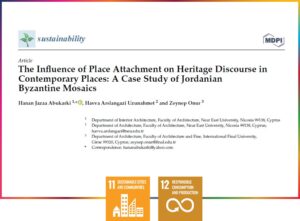
A collaborative study, with researchers Abukarki and Uzunahmet from Near East University, delves into the influence of place attachment on heritage discourse, focusing on Byzantine mosaics in Jordanian contemporary settings. Conducted in Madaba Archaeological Park, renowned as the “city of mosaics,” the research examines the replication and interpretation of these mosaics. Using structural equation modeling (SEM) and confirmatory factor analysis (CFA), the study investigates the relationship between place attachment, community awareness, and the discourse surrounding replicated heritage.
Findings reveal a strong emotional connection among participants to mosaic heritage places, particularly Madaba Archaeological Park, attributing to its historical significance and unique qualities. While participants acknowledge the cultural significance of Byzantine mosaics, they express less strong feelings of belonging to them, emphasizing the intricate link between cultural heritage, identity, and place attachment.
Efforts to educate the community about mosaic heritage, exemplified by initiatives like the Madaba Institute for Mosaic Art and Restoration, have proven successful in preserving and promoting this ancient tradition. Education plays a pivotal role in fostering attachment to heritage places and shaping discourse on replicated heritage in contemporary settings.
The study underscores the role of heritage replications as cultural tools for expressing identity and creating a sense of authenticity in modern architectural environments. Authenticity effects are heightened when replicas closely resemble the original, elevating the perceived value and prestige of the place.
Furthermore, the research highlights the positive association between place attachment, community education, and discourse on replicated heritage. Stronger place attachment correlates with increased community education, which, in turn, influences discourse surrounding heritage replication. This underscores the importance of fostering attachment to heritage places and promoting education to enhance heritage appreciation and preservation.
The study elucidates the significance of place attachment and community education in shaping discourse on replicated heritage in modern architectural environments. With a deeper understanding of heritage attachment and awareness, societies can better appreciate and preserve their cultural heritage. The findings provide valuable insights for future research and strategies for heritage preservation in Jordan and beyond.
More Information:
https://www.mdpi.com/2071-1050/15/10/8395